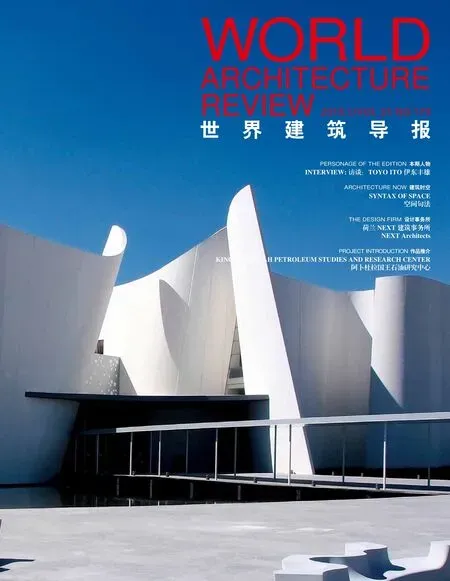访谈 Interview
导报:您的团队如何配合推进方案的设计?
伊东:所有项目均由设计团队负责,设计团队由若干名成员组成,包括首席建筑师和初级建筑设计人员,我本人亦为团队成员之一。通常,我会在首次会议上提出设计概念,随后团队成员在后续会议上对设计概念进行扩充。在该阶段,设计团队的所有成员,不论职位高低,均可平等表达各自意见。意见一经采纳,团队成员会共同制定设计方案,在该过程中,设计方案也会不断完善。设计团队同样会与结构和设备工程师等专业顾问进行多番讨论。
导报:您作品中追求轻薄结构、自由流动的空间,这是来自怎样的思考?
伊东:空气、水、光线等自然元素会因时间和季节的变化而不断转变。与之相反,建筑则相对静止和稳定。我个人十分重视自然要素及其在空间中的自由流动。因此,我相信建筑能够遵循类似的自然秩序,与自然及自然运动和谐共处。
导报:您认为游牧式的空间组织的当代意义是什么?
伊东:短居和搬家对于现如今的人们而言已成常态,对于生活在大城市的人尤为如此。家庭单元的含义不复如前。今日之建筑空间应当顺应和更适应瞬息万变的社会。
导报:您一些作品中运用到算法,能向我们谈谈您对参数化技术的态度和价值取向吗?
伊东:为使建筑更契合自然界规律,建筑设计应更多融入有机几何结构,而非纯几何结构。因此,我认为使用算法是创建流体建筑的有效工具。
导报:您追求建筑与自然的联系,挑战边界,很多作品在结构和施工上带来困难,您怎么去平衡这些问题?
伊东:随着当今世界技术进步,设计和建造综合性建筑已非难事。为应对当代社会的复杂形势,使用先进技术设计结构和设备实属必要。
导报:您会特意去落成的建筑中体验吗?建成后的空间使用是否如您原本所设想?
伊东:当然,我会前往现场参观竣工建筑。然而,在建筑竣工后,建筑本身的用途并非建筑师所能掌控,而且我认为建筑师亦无义务决定建筑的具体使用方式。只有当用户随心所欲自由使用建筑时,建筑的价值才真正得到体现。
导报:是否有让您存在遗憾的项目?
伊东:我认为项目的设计想法最终只有70%能够实现,但建筑师在整个设计过程中获得的经验以及缺憾,将成为下个设计项目的宝贵财富。
导报:现代主义思想是上世纪从西方传来的,深深的影响这着日本和中国的建筑设计。您认为您现在的实践是在尝试摆脱现代主义吗?
伊东:人类征服自然界和人类社会独立于自然界,是现代建筑理论的两大基础设想。然而,亚洲建筑流派认为人类社会从属于自然界。我本人更推崇打破静态和生硬现代建筑的亚洲衍生建筑。
导报:您如何看待日本当代建筑界,以及中国的当代建筑?
伊东:大量外形庞大、同质化的建筑正在占领日本和中国的各大城市。正如我在问题8中所说,现在是时候应该考虑未来的建筑发展方向。
导报:您如何看待现代建筑今后的变化趋势?
伊东:让自然环境与人造环境再度亲密无间,同时利用先进技术。
导报:您的建筑似乎一直在变,没有固定的套路,下一个方案可能走向何处?
伊东:我正在尽力实现问题10的答案。
导报:您创办了“伊东建筑塾”,面向成人及儿童授课,在教育实践中是否带来不同的体验?
伊东:当代教育缺乏创造性思维,限制了儿童丰富的想象力。创建让学生充分展开自由想象的平台是伊东建筑塾的创办宗旨。


WARA: How does your team cooperate to propel the design?
Toyo Ito:All projects are carried out by a team consisting of a few members including myself, chief architects and junior staあ. Typically, I initiate ideas at the fi rst meeting and then the team members develop the concept at the following meetings. During this phase, all members of the design team, regardless of position, equally present their viewpoints. Once an idea is adopted, design is developed collaboratively and constantly evolves during this process. The team will also have many discussions with consultants such as structural and mechanical engineers.
Toyo Ito:Natural elements such as air, water, light, etc. are continuously transforming according to time and seasons. Architecture, in contrast, tends to be static and stable. I value natural elements and their fl uid movement in space. Therefore, I believe architecture can be constructed to follow a similar natural order and be in tune with nature and its fl ows.
WARA: In your works, you pursue light and thin structure and fl owing space, what kind of thinking are these?
WARA: What do you think is the contemporary signi fi cance of nomadic spatial organization?
Toyo Ito:People nowadays, especially the ones who live in big cities are constantly moving and living transient lives. Conventions of the family unit are not as stable as they used to be in the past. Architectural spaces today should respond and be more adaptable to the changing society.
WARA: You use the algorithms in some works, can you tell us your attitude and value orientation to parameterized technology?
Toyo Ito:In order to make architecture closer to the rules of the natural world, design requires more organic geometry than pure geometry. Therefore, I fi nd using algorithm an eあective tool to create fl uid architecture.
WARA: You pursue the relationship between architecture and nature, challenge the boundary,and many works bring difficulties in structure and construction. How do you balance these problems?
Toyo Ito:With today’s technological development, it has become easier to both design and construct complex architecture. In response to the complexity of contemporary society, it is essential to consider structural and mechanical environments with advanced technology.
WARA: Will you go to experience the completed building designed by yourself on purpose? ls the space use as you originally envisaged?
Toyo Ito:Of course, I go on-site and visit the completed buildings. However, after construction completion architecture has a life beyond the control of the architect and I do not believe it is the architect's job to determine how the building is used functionally. Architecture serves its true purpose when it is vitalized by users who occupy the space freely as they wish.
WARA: Are there any items that leave you with regrets?
Toyo Ito: Ithink only 70% of projects’ ambition can be realized in the end. However, what you learn during the process and the inevitable regrets that arise can become the energy for the next project.
WARA: Modernism came from the West in the last century, which deeply in fl uenced the architectural design of Japan and china. Do you think your present practice is trying to get rid of modernism?
Toyo Ito:Modern architecture was created based on the foundation that humans conquer the natural world and that society is isolated from nature. However, principles in Asian thought believe that the built world is embedded in nature. I would like to disseminate Asian generative architecture that challenges static and rigid forms of modern architecture.
WARA: What do you think of the contemporary Japanese architectural environment and contemporary architecture in China?
Toyo Ito:Homogeneous and enormous architecture is dominating the contemporary urban landscape of both Japan and China. As answered in the question 8, we are now at the time to consider tomorrow’s architecture.
WARA: What do you think about the trend of modern architecture in the future?
Toyo Ito:Recuperating the intimate relationship between nature and the built environment and simultaneously utilizing the latest technologies.
WARA: Your building seems to have been changing, there is no fixed routine, and the next program may go where?
Toyo Ito:I am trying to take each step to realize the answer to the question 10.
WARA: You established "lTO JUKU" which not only attending class for adults but also for children,what are the different experiences in education practice?
Toyo Ito:Education today has become restrictive and as a result limits children’s rich imagination. Ito Juku’s primary aim is to create a platform to bring out the best of their freewheeling imagination.

